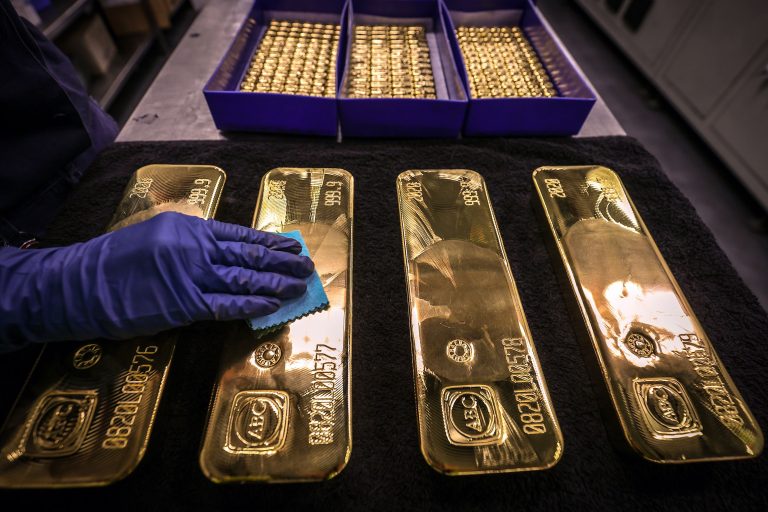Commentary
In recent years, governments and global organizations have been pushing for digital currencies. The International Monetary Fund speaks of “a new era of digital money,” while the World Economic Forum’s Digital Currency Governance Consortium calls “for the public sector to play a more decisive role” in shaping the “trajectory of digital currency development.”
The U.S. Federal Reserve is planning a digital dollar, and the People’s Republic of China is already marketing its digital yuan at home and abroad.
But amidst growing chatter of trackable and restrictable digital currencies, central banks are also scrambling to buy up a time-tested measure of value: gold.
Singapore last November announced the addition of 26 tons of gold to its reserves; Poland intends on procuring 100 tons in 2022 as insurance in case “someone cuts off the power to the global financial system.” Hungary, India, Ireland, and other countries beefed up their own gold reserves, France repatriated all its monetary gold and Zimbabwe has issued a gold tender to combat its notorious inflation.
Success
You are now signed up for our newsletter
Success
Check your email to complete sign up
China and Russia see gold as an increasingly valuable financial resource as tensions with the West rise. After being hit with massive sanctions over its invasion of Ukraine in February, the Kremlin reacted by pegging Russia’s currency to gold — boosting the ruble from its 121:1 ratio versus the U.S. dollar to 79 by early April.
‘The only real money’
As economic outlooks darken even after the COVID-19 pandemic fades, many fear increasing volatility in financial markets, something that would boost the performance of precious metals including gold and silver.
“Gold is the only real money, everything else is just credit,” Max Baecker, COO of American Hartford Gold, told Roman Balmakov, host of the YouTube show Facts Matter, in a recent interview.
“With central banks, you have to look at what they’re doing, not what they’re saying. Central banks have always been a big fan of gold,” he said in the Sept. 15 video.
Baecker gave an example from Venezuela’s financial crisis, when radical public welfare policies led to uncontrolled inflation and economic disaster. Russia stepped in to help stabilize the country in exchange for Venezuela’s gold reserves, rather than its currency holdings. “Gold is going to have its value,” he said.
According to Baecker, should the U.S. dollar ever lose its status as the world’s reserve currency, it would cause chaos throughout all other currencies, “and with that, the ultimate currency will be gold.”
In the U.S, M2 money supply increased by 80 percent in the last two years as the government printed trillions in stimulus money to prop up the economy, but with the consequence of triggering massive inflation.
With fears of a serious economic recession looming large — Jamie Dimon, Chairman and Chief Executive of JPMorgan Chase & Co warning of an unprecedented “hurricane” due to inflation — many are thinking about how to diversify their assets.
A repeat of 2008?
Currently, the U.S. dollar is strong despite massive increases in money supply during and following the pandemic because “money is fleeing bonds and money is fleeing the stock market,” Baecker told Balmakov.
He believes that there is a parallel between the present economic situation and 2008, when the world was reeling from a financial crisis that had begun the prior year.
Gold “went down” in 2008 due to the lingering strength of the dollar when “everything was heading south,” he said, noting the generally inverse relationship between gold and the value of the dollar. “Dollar falls, gold rises.”
He cited Goldman Sachs’ 2022 end-of-year prediction for gold to rise to $2,500 per ounce, which would be a 40-percent increase from the beginning of the year, when gold was down 4 percent compared with the start of 2021.
Gold prices rose from around $1,800 in early January to over $2,000 following the Russia-Ukraine war, then began to trail off in mid-April. According to APMEX, gold is currently trading at $1,664, as of press time.
In April 2020, Bank of America had given a forecast that would have had gold reaching $3,000 in 18 months, given the vast amounts of stimulus spending at the time. The prediction was made when gold was trading at a similar price to today.
However, Baecker says, financial institutions “see the writing on the wall, that everyone’s moved to the dollar… gold has fallen a bit, but it has not fallen on the same level as stocks, bonds, or the crypto market.”
Bitcoin has lost more than twice its value since the beginning of the year, falling from more than $47,000 in January to less than $20,000 at the time of writing.
Risks and opportunities
The precious metals market has been and is subject to deceptive moves by those in a position to profit from it, which can create confusion about the true or long-term worth of these commodities.
Balmakov brought up the recent case of Michael Nowak, global head of JP Morgan’s precious metals trading, who on Aug. 18 was found guilty in an Illinois court of “attempted price manipulation, commodities fraud, wire fraud, and spoofing prices in the gold, silver, platinum and palladium futures markets,” according to Bullion Star.
Baecker noted that many financiers have “placed thousands of false orders for precious metals, creating a ruse that lured others into making losing trades” in the practice known as spoofing, or when “a trader sends a large order to the market with the intent to cancel just before the execution” and thus goad others into “thinking there’s a huge demand or supply in the market.”
However, while manipulation is a danger, Baecker believes that worsening economic trends worldwide will push more investment toward gold out of practical, popular concern.
“Crews of guys can try to get together to spoof the market, they can try to create an arbitrage opportunity, they can suppress the price … but when you have a tsunami of people buying gold and silver, that price is going to rise no matter what.”
For small-time investors looking for some defense against inflation and other alarming trends, Baecker recommends buying physical gold or silver, or bullion and coins, rather than placing confidence in Exchange-traded funds (ETFs), which have lower premium prices but offer less security.
Another indication that precious metals are trending is the recent rise in premium prices.
“Before COVID you could buy [an American Silver Eagle] for $2.50 over spot [the nominal price of silver], and now that’s trading for 12 dollars and up,” Baecker observed. “Generally, the gold and silver market is not far behind that in terms of rising.”
















